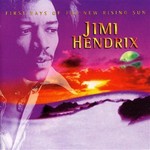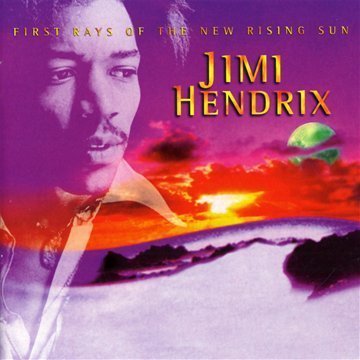| Artist |
Jimi Hendrix |
| Album Title: |
First Rays of the New Rising Sun |
| Album Cover: |
 |
| Primary Genre |
Rock: Classic Rock |
| Format |
CD (1) DVD (1) |
| Released |
12/19/1969 |
| Reissue Date |
03/09/2010 |
| Label |
Experience Hendrix / Sony Music Entertainment |
| Catalog No |
88697 62158 2 |
| Bar Code No |
8 86976 21582 8 |
| Reissue |
Yes |
| Remastered |
Yes |
| Packaging |
Digipack |
| Tracks |
| 1.
|
Freedom (3:26)
(Jimi Hendrix) |
| 2.
|
Izabella (2:50)
(Jimi Hendrix) |
| 3.
|
Night Bird Flying (3:50)
(Jimi Hendrix) |
| 4.
|
Angel (4:21)
(Jimi Hendrix) |
| 5.
|
Room Full of Mirrors (3:21)
(Jimi Hendrix) |
| 6.
|
Dolly Dagger (4:44)
(Jimi Hendrix) |
| 7.
|
Ezy Rider (4:09)
(Jimi Hendrix) |
| 8.
|
Drifting (3:48)
(Jimi Hendrix) |
| 9.
|
Beginnings (4:12)
(Jimi Hendrix) |
| 10.
|
Stepping Stone (4:12)
(Jimi Hendrix) |
| 11.
|
My Friend (4:36)
(Jimi Hendrix) |
| 12.
|
Straight Ahead (4:42)
(Jimi Hendrix) |
| 13.
|
Hey Baby (New Rising Sun) (6:04)
(Jimi Hendrix) |
| 14.
|
Earth Blues (4:21)
(Jimi Hendrix) |
| 15.
|
Astro Man (3:34)
(Jimi Hendrix) |
| 16.
|
In From the Storm (3:41)
(Jimi Hendrix/(P) 1997 Experience Hendrix L.L.C.) |
| 17.
|
Belly Button Window (3:36)
(Jimi Hendrix/(P) 1997 Experience Hendrix L.L.C. under license to MCA Records, Inc.) |
|
| Date Acquired |
04/03/2010 |
| Personal Rating |
 |
| Acquired from |
Amazon |
| Purchase Price |
9.99 |
| Reviews |
All Music Guide Review:
Review by Cub Koda & Sean Westergaard
Because Hendrix's death in September 1970 occurred before his work on these tunes was completed, the questions still abound as to what Hendrix's ultimate vision for this double album would have been. Minus the worthless -- though well-intentioned -- overdubs and remix manipulation that occurred when this material was issued piecemeal over the years on The Cry of Love, War Heroes, Rainbow Bridge, and the disappointing Voodoo Soup, this collection finally gets listeners back to the master tapes residing in the Electric Ladyland vaults, and as close to what Hendrix had in mind as possible (as subject to change as these versions obviously were), and also places the tunes in their original context as an album. Because this collection utilizes mixes that Hendrix and engineer Eddie Kramer were working on at the time, the tracks perhaps lack the sonic wallop of the first three Experience albums, but have much more to offer than the stripped-away and re-dubbed versions that have been on the market. If one views First Rays of the New Rising Sun as an almost-completed work in progress, then it becomes obvious that Hendrix was heading in a new direction and sound, one rife with funk and rhythm & blues as a bedrock foundation. The psychedelic workouts got more jam-like and experimental, and the ballads got prettier and even more dreamlike in their background soundscapes. What he would have eventually come up with and release as his next musical statement is anyone's guess, but this gets you as close to that answer -- and that vision -- as you're ever likely to get.
The 2010 Legacy edition adds a short documentary DVD featuring interviews with Mitch Mitchell and Billy Cox, as well as Eddie Kramer in the studio with the multi-track masters. Kramer takes us though the evolution of the tune "Angel" by playing parts of the original Olympic demo and a solo home demo before getting to the issued take. We also get to hear an instrumental demo for "Freedom," but the best part is when he breaks down a bunch of the guitar parts from "Night Bird Flying." There is also some great live footage of Jimi performing "Dolly Dagger" and "In from the Storm."
Other Comments:
Posthumous reconstructions of unfinished works are inherently dangerous, principally because even the most capable scholar or producer can only make, at best, an educated guess as to how the work in question would have been completed. Indeed, in dealing with some such pieces, you're sometimes lucky to get the work of the artist claimed (the Mozart Symphony No. 37 is a case in point — it doesn't exist; the piece once labeled Symphony No. 37 and attributed to Mozart is now known to have been authored by Michael Haydn); and while there's no question that the songs on this CD were recorded by Jimi Hendrix, even the people who worked on the sides with him can't say which songs would have ended up on the finished version of First Rays of the New Rising Sun (assuming that he even ended up using that title for the album), or what embellishments he would have added to any of them in the course of completing them, or even if he might not have totally reconsidered such matters as tempo and approach to any of them. In the end, First Rays of the New Rising Sun is a little like any of the various "performing editions" of Gustav Mahler's never-completed Symphony No. 10, in that what's here is impressive, but may have little to do with what would finally have been heard by the public, had the artist lived to finish it — we don't know if Mahler would have scored a particular passage for horns or strings, or Hendrix would have put another, different lead guitar part, or a second (or third) guitar part on to any of these songs, or added choruses, or re-thought his vocal performance? Hendrix had gone so long between albums, seemingly adrift stylistically at various times, that there's no telling exactly what direction he was finally going to end up working toward. All of that said, this is a superb album, and a worthy if very different, earthier successor to Electric Ladyland's psychedelic excursions — the later tracks, ironically enough, cut at that album's long promised and long-delayed studio namesake — and also show him working in some genuinely new directions. For starters, Hendrix's voice emerges here as a genuinely powerful instrument in its own right — his voice was never as exposed in the mix of his songs as it is here; partly this is because Hendrix and engineer Eddie Kramer never finished embellishing the songs, or completed the final mixes. But whatever the reasons, the change is refreshing — Hendrix's voice is not only powerful and expressive throughout, but a more melodic instrument than it seemed on his earlier releases; indeed, hearing these sides is a bit like listening to those middle-years Muddy Waters recordings when Chess Records had the Chicago blues legend abandon his guitar playing in favor of concentrating on his singing; the results might not be what all fans expected, but it sure sounds good, because it turns out that Hendrix had an expressive voice and was also moving his music into new areas that were stimulating him. A lot of the materi
|
|
| Cover 1 |
 |
|



